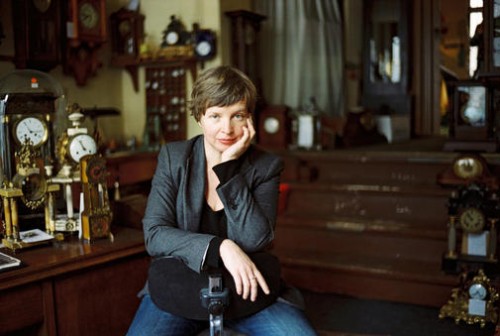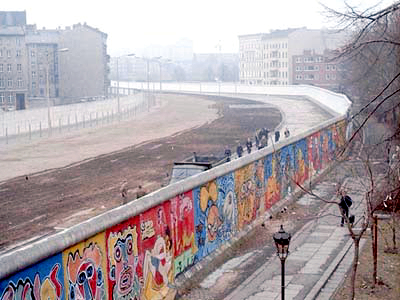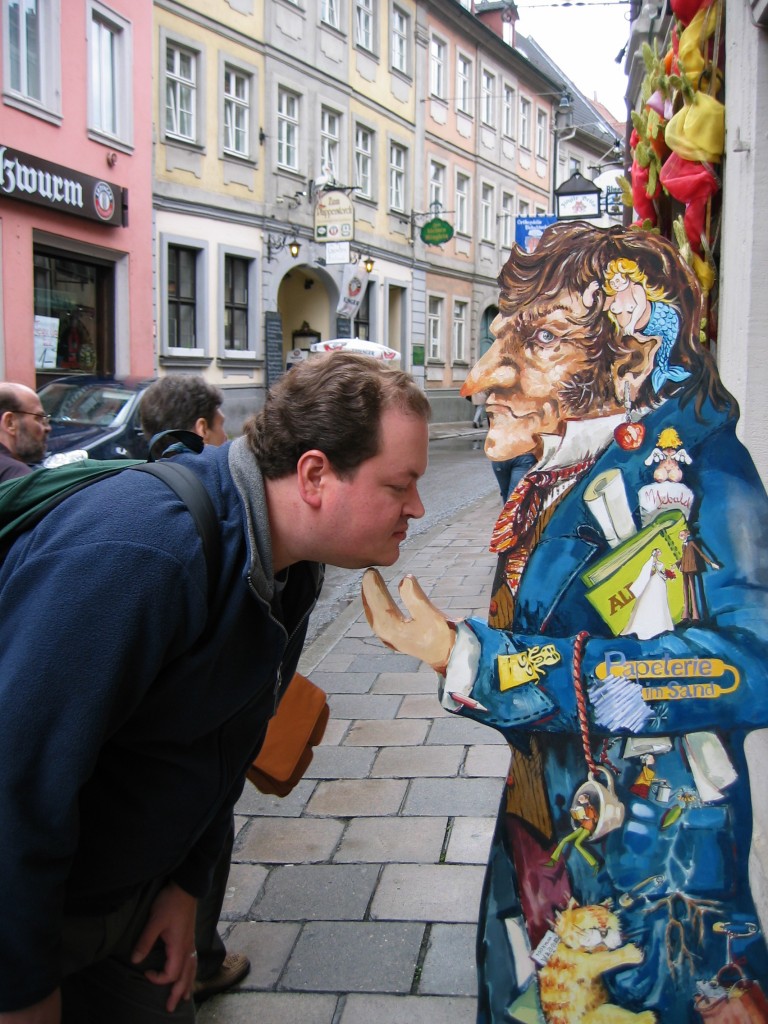The End of Days explores allegiance to family, to friends, to ideology. It is a story of Jewish identity, and of persecution. It is a story about boundaries and the borders between nations, between people, between ideas, between faiths. It is about the divisions we create within ourselves and the horizon where life meets death. Here is a novel that seeks no less than “the weave of life in its entirety.” — Frank Richardson
End of Days
Jenny Erpenbeck
New Directions, 2016
Paperback $15.95, 240 pages
.
When I discovered Jenny Erpenbeck’s The End of Days, I remember how disappointed I was that I would never get to review this remarkable novel. Susan Bernofsky’s translation of Aller Tage Abend had been published in 2014 by New Directions, had won major literary awards, and had received a plethora of accolades from critics across the globe. Damn it, I thought—how often does one get the opportunity to write about such a gem? But, it’d been done and done well, and I had a thesis to write anyway. Six months later, while trolling publishers’ websites, I was delighted to see the novel was being released as a New Directions paperback. Fate and a generous editor would grant me a second chance. Erpenbeck has penned a novel of rare excellence and beauty, a novel of questions that lets you swim in possibility, and it’s all about second chances.
Born in 1967 in East Berlin, Jenny Erpenbeck studied theater directing with Heiner Müller, has worked with Werner Herzog, and has had a distinguished career directing in opera houses in Germany and Austria. In 1999, she published her first prose fiction—the eerie, fable-like novella The Old Child—which quickly garnered international attention. For her first novel, Visitation, she won the Hertha König Prize 2008, and for The End of Days she won the Independent Foreign Fiction Prize (2015) and the Hans Fallada Prize (2014). Her most recent novel—Gehen, Ging, Gegangen (Knaus, 2015)—was short-listed for the 2015 German Book Prize. An English translation from Erpenbeck’s long-time collaborator Susan Bernofsky is, hopefully, forthcoming. The End of Days is the fourth of Erpenbeck’s books translated by multi-award-winning Bernofsky, noted for her translations of Robert Walser, Hermann Hess, and Franz Kafka. Her translations of Erpenbeck’s fiction have won numerous prizes including the 2005 PEN Translation Fund Award (The Old Child), and for The End of Days she won the 2015 Oxford-Weidenfeld Translation Prize and the 2015 Ungar German Translation Award.
The End of Days explores allegiance to family, to friends, to ideology. It is a story of Jewish identity, and of persecution. It is a story about boundaries and the borders between nations, between people, between ideas, between faiths. It is about the divisions we create within ourselves and the horizon where life meets death. Here is a novel that seeks no less than “the weave of life in its entirety.”
Possibilities
It is the year 1902 in a small provincial town in Galicia, present day Ukraine, near the border with Poland. A mother drops handfuls of dirt into the open grave of her baby girl who died mysteriously, her breathing simply stopped. She will not be consoled and imagines her daughter’s life—her playing the piano, her coppery hair, her aiding her mother in old age. She thinks about the mound of earth that tops all fresh graves, that for her child’s it should be as “huge as the Alps,” symbolic of the potential her daughter has lost. The eighteen-month old girl is, however, the protagonist of this story, and she will be resurrected and die four more times.
The 240-page novel is organized as a series of five numbered books of roughly equal length. Each book explores a possible life for the central character, unnamed until book three. The books are separated by short (three-to-eight page) “intermezzos” that serve as segues; here especially the narrator explores what might have been. The concept of a multiverse—that all possible lives are lived in all possible universes—isn’t new, and many authors have used the conceit of parallel universes, but The End of Days isn’t that kind of novel. Not really. The main plot, loosely based on Erpenbeck’s family, follows a single character (let’s call her H.) from her birth in Brody to her life in post WWI Vienna, her joining the Communist Party and emigration to the Soviet Union, and her career as a writer in the German Democratic Republic. Periodically, throughout the course of this plot arc, Erpenbeck’s narrator presents a scenario where H. dies. She then presents a contrary scenario in an intermezzo and subtly opens a new, yet linked narrative. The resulting effect suggests multiple lives, and while her solution looks straightforward and easy, it is a testament to Erpenbeck’s artistry that she can shift the direction of her narrative so effortlessly.
Great characters ground great books, and H.’s diverse histories reflect her complex character. She is courageous, stubborn, willful, loving and loyal, but capable of spite. She is an artist, a writer of novels, stories, and radio plays, who writes “in defense of the beautiful and true.” With each book, her desires shift with her fortunes: in Vienna she falls in love with her best friend’s fiancé while struggling to avoid starvation; in Moscow she must literally write for her life, either to succeed and become a Soviet citizen, or fail and die in a gulag; and in East Berlin, at the height of a brilliant literary career, when faced with losing all she has ever known, she longs most for contact with her son. In an interview Erpenbeck said she wanted “to look at the question of how present death is in our lives, and how our paths change when people close to us remain or leave.” And so, while H. is the focal point, the subplots of richly imagined secondary characters swirl around her. Here, Erpenbeck doesn’t waste a word showing us the regret of H.’s grandmother:
That morning, for the sake of her daughter’s happiness, she had sold her daughter’s happiness. Sometimes the price one pays for something continues to grow after the fact, becoming too expensive long after it has been paid.
Each book comprises numerous short chapters (many only a paragraph long). A third-person omniscient narrator limits herself to a single character in each chapter and shifts focalization with chapter breaks. After some focalization shifts Erpenbeck uses pronouns without antecedents, deliberately blurring the point of view, asking us to acknowledge that all her characters could share the life she describes. This can be slightly confusing, but the character’s identity becomes clear from the context before confusion turns to frustration and rereading. Few characters have proper names, one of the author’s trademarks. Although the linear chronology begins in 1902 and ends ninety years later, in some books Erpenbeck employs nonlinear time as she shifts character focalization, e.g. in the fourth book, while days pass for one character, for another character time is suspended in an instant. Despite multiple books and chapters, changes in character focalization, and use of nonlinear time, the narrative is a harmonious, resonant whole, a vision of the ramification of our lives and the consequences of our choices.
Borderlands
Erpenbeck leaves no detail unexamined in her intricately interwoven patterns of images, metaphors, and symbolic associations. Given that she grew up in East Berlin, perhaps it is not a coincidence that the primary images of The End of Days are borders, although she writes (Paris Review) and speaks fondly of her childhood and adolescence.
First, there are the geographic borders: H. is born in a border town, and after both World Wars, the borders of Europe are redrawn; Germany is divided. There are subtler borders of place, and propriety—for example, a friend must drop a letter across the threshold of a window since to hand it to the receiver would constitute working on the Sabbath. Then there is the border between faiths: after marrying a Christian, H.’s Jewish mother is left “hanging between two worlds.” While trying to reconcile her imminent death in the Soviet Union with her decision to join the Communist Party, H. questions the “irreversibility of good and evil” and “whether hope had boundaries or not.” And, at the end of her life, ninety years old and slipping into dementia, H. confronts the border between memory and oblivion. As in reality, the link to the ultimate border, death, comes in many forms. Sometimes it is the vagaries of nature—a cold front results in a frozen puddle that turns one’s course toward a deadly encounter. Sometimes the cause is a conscious decision, suicide the only answer. Sometimes the whim of a petty bureaucrat sends you to Siberia, and sometimes it is just the inexplicable, absurd folly of falling down the stairs.
While this strong pattern of boundaries serves as the backbone of her novel, Erpenbeck uses a myriad of other recurring, interconnected images. To cite just one example, H.’s heirloom collection of Goethe’s complete works appears throughout the course of the novel. The books figure prominently during the episode when H.’s grandparents are attacked; the scene is replete with border imagery, including: the boundary between inside and outside their home; the threshold of an opening onto the roof and the violent tug of war between the mob and those who are trying to flee; and the boundary of life itself. Each time the books appear, including volume nine with its scraped spine from where a rock hit it during the attack, we are brought back to this scene. Sometimes specific poem titles or lines of Goethe’s poetry are used to tie the associated images together. Of course, books are made of words, and language becomes a fixation of H.’s father, who concludes we each have our own vocabulary for the “constant translation between far outside and deep within.” The books accumulate various associations as the story progresses and become, in the end, a focal point of sublime reminiscence.
On Style
Jenny Erpenbeck’s style of prose and her choices for the novel’s organization demonstrate a deep sensitivity to language. The intermezzos serve as borders between possible lives, stylistically mimicking the imagery of boundaries. The last chapter of the first book is an amalgamation of points of view from all the characters up to that moment. From one sentence to the next, then within a sentence, then from word to word, Erpenbeck tells us what the characters are doing (she shifts to the present tense) and what their lives have become in a montage that culminates with the single question that plagues the father, the mother, and the grandmother: why did the baby die? After the reader turns the page, the next logical thought is “But if . . .” and the baby is saved from its mysterious loss of breath by a handful of snow rubbed against her chest. She is revived, and in the first intermezzo we are asked to imagine an alternate life for the young family, the parents never having been burdened with a devastating loss, and the daughter who becomes a young woman. The intermezzo provides an opportunity for reflection, for imagining multiple scenarios beyond the one continued in the narrative.
While it may be imprudent to address prose style in a translated work—after all, isn’t so much of style untranslatable?—nevertheless, Bernofsky’s translation is so expert, so pitch-perfect, it is worth the risk. Regarding the translation, Erpenbeck said in an interview:
I did feel that it was really my book. It was perfectly done. Sometimes her translation is so perfect that I don’t even know the vocabulary she has used.
Erpenbeck’s prose swings between the concise precision of a proverb: “The forest provides the wood for the axe that will chop it down” to the lyrical sinuosity of memory:
For one brief, sharp, clear moment, he understands what it would be like if he could arrive there along with her: The wheat field would be there right from the start, just like the rustling of the leaves at his back, the silence would be filled to the brim—that deafening crack living only in his memory, absent now—and the memory that filled out this silence would be just as real as the footsteps of all the human beings walking upon the earth at this moment, along with their falling down, their jumping, crawling, and sleeping at this very moment, just as real as all that mutely lay or flowered within the earth . . .
Erpenbeck’s longer sentences are not inchoate stream of consciousness demonstrations. They serve, beautifully, the needs of her scenes, her characters, and her themes. When immigrants wait at Ellis Island (a border, intermezzo place), pensive about their admittance into America, the anaphora and rhythm of the sentence becomes the tolling of Donne’s bell:
The people squat, lie on the ground, or sit on benches: people with bundles, bedding, and crates, with samovars, people without any baggage at all, children running about . . . people who are filled with hope, with despair, people who are homesick, frightened, people who don’t know what’s in store for them, people who are wondering where they’ll find the twenty-five dollars for their immigration fee, people who suddenly want to go back . . .
And it’s not an accident that this scene, which occurs in the first book, is echoed in a memory only a few pages from the end of the novel.
***
The End of Days, a book of elegant style and penetrating insight, filled with arresting characters and provocative questions, is a book to come back to a second time, and a third, and . . . who knows how many times? Erpenbeck writes with a gentle intensity—a feeling light as a dream yet so grounded in the moment that if a grenade exploded outside your window, you wouldn’t jump. Although death frames the novel, The End of Days celebrates the beginning of days, for it affirms life’s multiplicity and the potential of every human life. Erpenbeck quotes W. G. Sebald’s Austerlitz in an epigraph; in part, he asks—“where will we be going now?” This question vibrates throughout her novel and remains with us as we move on from this book, and this life, to the next.
— Frank Richardson
NC
Frank Richardson lives in Houston and received his MFA in Fiction from Vermont College of Fine Arts. His poetry has appeared in Black Heart Magazine, The Montucky Review, and Do Not Look At The Sun.
.
.




